英语语法-句子的种类(史上最详细)
句子的种类介绍

句子的种类介绍句子的种类介绍(一)按使用目的可分为陈述句、疑问句、祈使句和感叹句。
1)陈述句(Declarative Sentences):说明一个事实或陈述一种看法。
Light travels faster than sound. 光比声速度快。
(说明事实)The film is rather boring. 这部电影很乏味。
(说明看法)2)疑问句(Interrogative Sentences):提出问题。
有以下四种:a. 一般疑问句(General Questions):Can you finish the work in time?你能按时完成工作吗?b. 特殊疑问句(W Questions; H Questions):Where do you live? 你住那儿?How do you know that? 你怎么知道那件事?c. 选择疑问句(Alternative Questions):Do you want tea or coffee?你是要茶还是要咖啡?d. 反意疑问句(Tag-Questions):He doesn't know her, does he?他不认识她,对不对?3)祈使句(Imperative Sentences):提出请求,建议或发出命令,例如:Sit down, please. 请坐。
Don't be nervous! 别紧张!4)感叹句(Exclamatory Sentences):表示说话人惊奇、喜悦、愤怒等情绪,例如:What good news it is! 多好的消息啊!(二)句子按其结构可以分为以下三类:1)简单句(Simple Sentences):只包含一个主谓结构句子叫简单句,例如:She is fond of collecting stamps. 她喜欢集邮。
(主) (谓)2)并列句(Compound Sentences):包含两个或两个以上主谓结构的句子叫并列句,句与句之间通常用并列连词或分号来连接,例如:The food was good, but he had little appetite.(主) (谓) (主)(谓)食物很精美,但他却没什么胃口。
英语语法-句子的种类

高中英语语法组成句子的各个部分叫句子成分。
英语句子成分有主语,谓语,表语,宾语,宾语补足语,定语,状语等。
顺序一般是主语,谓语,宾语,宾语补足语,而表语,定语,状语的位置要根据情况而定。
1、主语主语表示句子主要说明的人或事物,一般由名词,代词,数词,不定式等充当。
Helikeswatch'ingTV.他喜欢看电视。
2、谓语谓语说明主语的动作,状态或特征。
1),简单谓语由动词(或短语动词)构成。
可以有不同的时态,语态和语气。
Westud'yforthepeo'ple.我们为人民学习。
2),复合谓语:情态动词+不定式Icanspeakalit'tleEng'lish.我可以说一点英语。
3、表语表语是谓语的一部分,它位于系动词如be之后,说明主语身份,特征,属性或状态。
一般由名词,代词,形容词,副词,不定式,介词短语等充当。
Mysis'terisanurse.我姐姐是护士。
4、宾语宾语表示动作行为的对象,跟在及物动词之后,能作宾语的有名词,代词,数词,动词不定式等。
WelikeEng'lish.我们喜欢英语。
有些及物动词可以带两个宾语,往往一个指人,一个指物,指人的叫间接宾语,指物的叫直接宾语。
Hegavemesom'eink.他给了我一点墨水。
有些及物动词的宾语后面还需要有一个补足语,意思才完整,宾语和它的补足语构成复合宾语。
如:Wemakehimourmon'itor.我们选他当班长。
5、定语在句中修饰名词或代词的成分叫定语。
用作定语的主要是形容词,代词,数词,名词,副词,动词不定式,介词短语等。
形容词,代词,数词,名词等作定语时,通常放在被修饰的词前面。
Heisanewstu'dent.他是个新生。
但副词,动词不定式,介词短语等作定语时,则放在被修饰的词之后。
Thebikeintheroomismine.房间里的自行车是我的。
英语语法句子大全
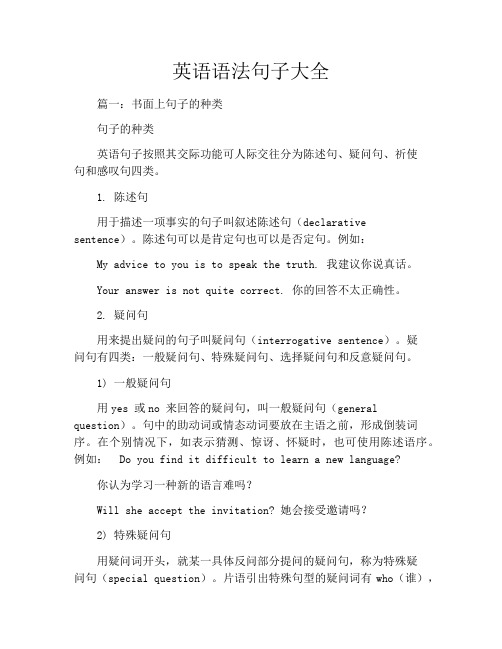
英语语法句子大全篇一:书面上句子的种类句子的种类英语句子按照其交际功能可人际交往分为陈述句、疑问句、祈使句和感叹句四类。
1. 陈述句用于描述一项事实的句子叫叙述陈述句(declarative sentence)。
陈述句可以是肯定句也可以是否定句。
例如:My advice to you is to speak the truth. 我建议你说真话。
Your answer is not quite correct. 你的回答不太正确性。
2. 疑问句用来提出疑问的句子叫疑问句(interrogative sentence)。
疑问句有四类:一般疑问句、特殊疑问句、选择疑问句和反意疑问句。
1) 一般疑问句用yes 或no 来回答的疑问句,叫一般疑问句(general question)。
句中的助动词或情态动词要放在主语之前,形成倒装词序。
在个别情况下,如表示猜测、惊讶、怀疑时,也可使用陈述语序。
例如: Do you find it difficult to learn a new language?你认为学习一种新的语言难吗?Will she accept the invitation? 她会接受邀请吗?2) 特殊疑问句用疑问词开头,就某一具体反问部分提问的疑问句,称为特殊疑问句(special question)。
片语引出特殊句型的疑问词有who(谁),whom(谁),whose(谁的),which(哪个),what(什么),where (哪里),when(何时),why(为什么),how(如何)等。
例如:Who will come tomorrow?明天谁会来? What are you doing there? 你在那儿干什么? When did they get married? 他们是什么时候结婚的?Where did you find the book? 你在哪里辨认出的这本书?3)选择疑问句说话人提供两种或者两种以上的情况供对方做出的疑问句,叫选择疑问句(alternative question)。
高三英语语法句子种类与类型

1、陈述句 说明一个事实或陈述一个看法,有肯定式和否 定式,语序是主语在前,位于在后。
I
She arrived early.
She cannot have arrived now.
、 句
注:1)半否定句
子
I hardly know anything about it.
种 类
2)部分否定句与全否定句
I
2、疑问句 有一般疑问句、特殊疑问句、选择 疑问句、反义疑问句。
1)一般疑问句 用来询问一件事,答案通常是yes或 no,注意语序。
、 句
Have you anything to say?
子
种
Did someone phone me last night?
类
Can’t you understand it?
句
(2)倒装语序
子
种
Who are you talking about?
类
注:A、简略式 Why not go alone? Why get so angry? How/What about taking a rest?
B、复杂特殊疑问句
What do you think he has done?
3)选择疑问句
I
(1)以一般疑问句为基础
、
Is he a teacher or a doctor or a policeman?
句
子
Shall I help you or can you manage?
种
类
(2)以特殊疑问句为基础 Which do you prefer, red wine or white? How shall we go there? By bus or by train?
英语语法-句子的种类(史上最详细)
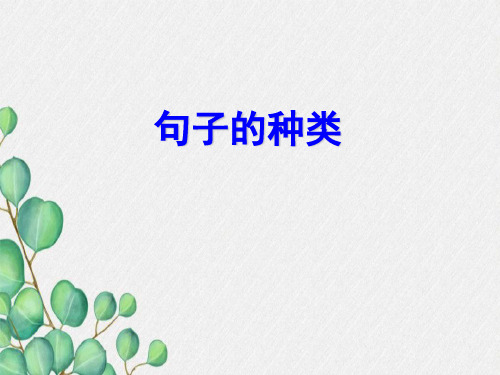
(4) 现在完成时和过去完成时的一般疑问句。 将助动词 have/has /had提至句首。 You have known her since your childhood? Have you known her since your childhood? 你从童年时就认识她吗? Yes I have /No I haven’t He had learned English before he came here? Had he learned English before he came here? 他来这之前就学过英语吗? Yes he had / No he hadn’t.
2.感叹句的种类
感叹句一般用what 或how开头,其具体用法如下:
(1) what引导的感叹句 (中心词是名词)
①What +a/an+ 形容词+可数名词单数(+主语+谓语)!
What a cold day (it is) !
多么冷的一天啊!
What a clever boy (he is)! 多么聪明的男孩!
句子的种类
英语的句子按照用途可分为四类:陈述句、疑问句、祈使 句和感叹句。
(一)陈述句
用来陈述一件事实或表达说话者看法的句子叫作陈述句, 句末用句号表示句子的陈述结束。陈述句分为肯定句和否 定句。 I like apples. 我喜欢苹果。 Tom is not good at English. 汤姆英语学得不好。
(2) 情态动词的一般疑问句。 陈述句中有情态动词,直接将情态动词提至主语前。 You can bring me some bread. Can you bring me some bread? Yes I can / No I can’t I must do it now. Must I do it now? Yes you must / No you need not.
高三英语语法句子种类与类型
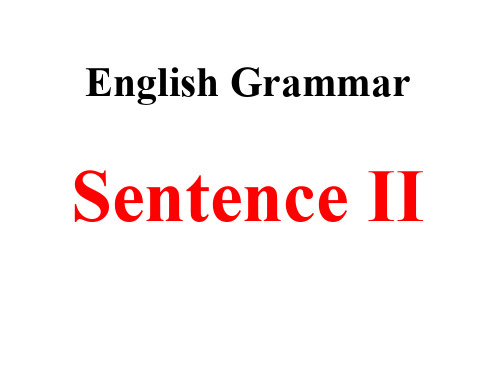
Sentence II
英语句子种类与类型
I、句子种类(按交际用途分) 陈述句、疑问句、祈使句、感叹句、 THERE-BE存在句
II、句子类型(按句子结构分) 简单句、并列句、复合句、并列复合句
提 纲
I、句子种类(按交际用途分)
陈述句、疑问句、祈使句、 感叹句、THERE-BE存在句
2、疑问句 有一般疑问句、特殊疑问句、选择
疑问句、反义疑问句。
1)一般疑问句 用来询问一件事,答案通常是yes或
I
no,注意语序。
、
Have you anything to say?
句
子
Did someone phone me last night?
种
类
Can’t you understand it?
Isn’t it a beautiful lake?
---Haven’t you been to the UK?
---No, I haven’t.
2)特殊疑问句 疑问词有
who,whose,what,which,where,when,why,how等。
(1)陈述语序
I
Who was the first man in space?
、
(2)倒装语序
Hale Waihona Puke 句 子Who are you talking about?
种
类
注:A、简略式
Why not go alone? Why get so angry?
I like neither Cathy nor Mary.
3)否定转移
I don’t think it will be very cold today.
高考英语语法句子类型及句子成分基础知识
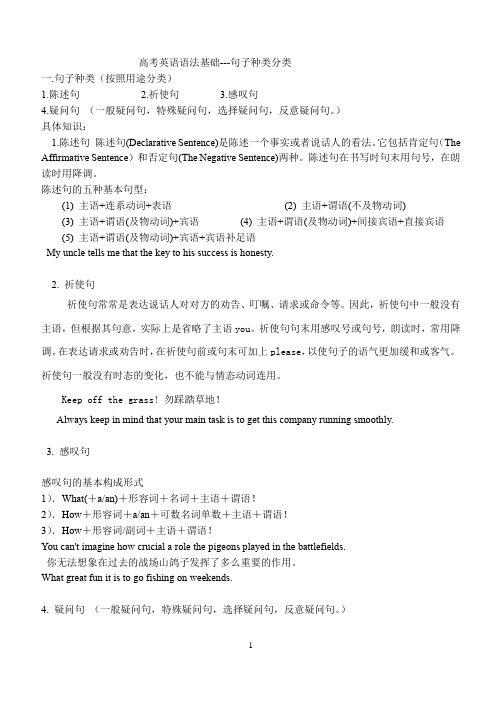
高考英语语法基础---句子种类分类一.句子种类(按照用途分类)1.陈述句2.祈使句3.感叹句4.疑问句(一般疑问句,特殊疑问句,选择疑问句,反意疑问句。
)具体知识:1.陈述句陈述句(Declarative Sentence)是陈述一个事实或者说话人的看法。
它包括肯定句(The Affirmative Sentence)和否定句(The Negative Sentence)两种。
陈述句在书写时句末用句号,在朗读时用降调。
陈述句的五种基本句型:(1) 主语+连系动词+表语(2) 主语+谓语(不及物动词)(3) 主语+谓语(及物动词)+宾语(4) 主语+谓语(及物动词)+间接宾语+直接宾语(5) 主语+谓语(及物动词)+宾语+宾语补足语My uncle tells me that the key to his success is honesty.2. 祈使句祈使句常常是表达说话人对对方的劝告、叮嘱、请求或命令等。
因此,祈使句中一般没有主语,但根据其句意,实际上是省略了主语you。
祈使句句末用感叹号或句号,朗读时,常用降调。
在表达请求或劝告时,在祈使句前或句末可加上please,以使句子的语气更加缓和或客气。
祈使句一般没有时态的变化,也不能与情态动词连用。
Keep off the grass! 勿踩踏草地!Always keep in mind that your main task is to get this company running smoothly.3. 感叹句感叹句的基本构成形式1).What(+a/an)+形容词+名词+主语+谓语!2).How+形容词+a/an+可数名词单数+主语+谓语!3).How+形容词/副词+主语+谓语!You can't imagine how crucial a role the pigeons played in the battlefields.你无法想象在过去的战场山鸽子发挥了多么重要的作用。
初中英语语法句子的种类

初中英语语法句子的种类英语是国际通用语言,掌握良好的英语语法对于初中学生来说至关重要。
在学习英语语法时,了解并掌握不同种类的句子结构和用法是必不可少的。
本文将介绍初中英语语法中常见句子的种类,并对其结构和用法进行详细解析。
一、陈述句(Declarative Sentence)陈述句是最常见的句子类型,用于陈述事实、描述情况等。
陈述句一般由主语和谓语构成,常见的谓语动词有实义动词和系动词。
例如:1. My brother likes playing basketball.(我的弟弟喜欢打篮球。
)2. The cat is black.(这只猫是黑色的。
)二、疑问句(Interrogative Sentence)疑问句用于询问问题,一般以动词开头。
根据回答方式,疑问句可分为一般疑问句和特殊疑问句。
1. 一般疑问句(Yes/No Questions):一般疑问句的回答通常是“Yes”或“No”。
构成方式:助动词(或者是be动词)+主语+谓语动词(去掉助动词)+其他?例如: Are you happy?(你开心吗?)Does he like swimming?(他喜欢游泳吗?)2. 特殊疑问句(WH-Questions):特殊疑问句通常以疑问词(如what, where, when, why, how等)开头,回答需要提供具体信息。
例如:What is your name?(你叫什么名字?)Where does she live?(她住在哪儿?)三、祈使句(Imperative Sentence)祈使句用于表达请求、命令或建议等,一般省略主语。
常用动词原形构成祈使句,例如:1. Sit down, please.(请坐。
)2. Don't be late for class.(上课不要迟到。
)四、感叹句(Exclamatory Sentence)感叹句用于表达强烈的感情或情绪。
常常以感叹词(如how, what 等)开头。
英语语法句子的种类
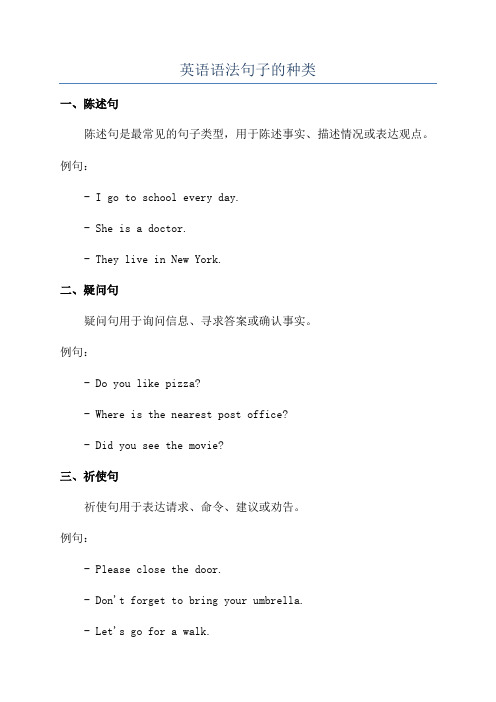
英语语法句子的种类一、陈述句陈述句是最常见的句子类型,用于陈述事实、描述情况或表达观点。
例句:- I go to school every day.- She is a doctor.- They live in New York.二、疑问句疑问句用于询问信息、寻求答案或确认事实。
例句:- Do you like pizza?- Where is the nearest post office?- Did you see the movie?三、祈使句祈使句用于表达请求、命令、建议或劝告。
例句:- Please close the door.- Don't forget to bring your umbrella.- Let's go for a walk.四、感叹句感叹句用于表达惊讶、赞美、失望或其他强烈的情感。
例句:- What a beautiful sunset!- How delicious the food is!- I can't believe we won the game!五、条件句条件句用于表达条件和结果之间的关系。
例句:- If it rains, we will stay indoors.- Unless you study hard, you will fail the exam.六、比较句比较句用于表示两个或多个事物之间的比较。
例句:- John is taller than Peter.- She sings better than him.- I prefer coffee to tea.七、否定句否定句用于否定陈述句中的内容。
例句:- I didn't see him at the party.- She doesn't like spicy food.- They haven't visited that museum before.。
英语语法之句子的种类
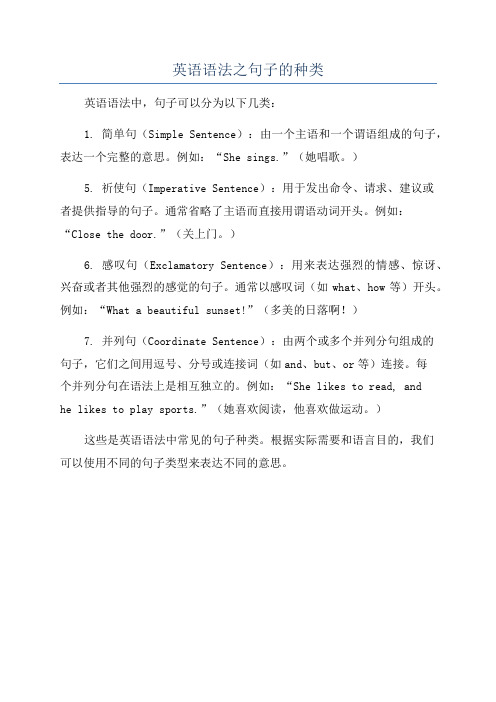
英语语法之句子的种类
英语语法中,句子可以分为以下几类:
1. 简单句(Simple Sentence):由一个主语和一个谓语组成的句子,表达一个完整的意思。
例如:“She sings.”(她唱歌。
)
5. 祈使句(Imperative Sentence):用于发出命令、请求、建议或
者提供指导的句子。
通常省略了主语而直接用谓语动词开头。
例如:“Close the door.”(关上门。
)
6. 感叹句(Exclamatory Sentence):用来表达强烈的情感、惊讶、兴奋或者其他强烈的感觉的句子。
通常以感叹词(如what、how等)开头。
例如:“What a beautiful sunset!”(多美的日落啊!)
7. 并列句(Coordinate Sentence):由两个或多个并列分句组成的
句子,它们之间用逗号、分号或连接词(如and、but、or等)连接。
每
个并列分句在语法上是相互独立的。
例如:“She likes to read, and
he likes to play sports.”(她喜欢阅读,他喜欢做运动。
)这些是英语语法中常见的句子种类。
根据实际需要和语言目的,我们
可以使用不同的句子类型来表达不同的意思。
英语语法中的9种句子成分

英语语法中的9种句子成分一.主语Subject“主语”中的“主”是主人、主导的意思。
(一)定义:主语是动作的发出者,通常为一个句子中第一个独立的名词【或名词性结构】。
也可以理解为主语就是句子中说明的人或事物【sb/sth】独立的:即不在短语中、不在从句中(二)句子中主句的4种形式:1.名词本身2.代词3.动词-ing/to do形式【注意:做状语的V-ing/to do 结构除外】4.主语从句【即主语是个句子,引导词that 不可省略】例句:The flower is beautiful.I love you.Teaching English is my job.To teach English today is my job.(补充:动词做主语的-ing形式称为动名词,to do形式称为不定式。
前者强调经常性、习惯性,后者强调阶段性、特定性、将来性。
)That she is still alive is a wonder.二.谓语Predicate(一)定义:谓语是主语发出的动作,通常为主语后的第一个独立的动词【或动词性结构】。
也可以说是用来说明主语的动作、状态和特征。
例句:He is singing.(其中的is是助动词,is singing 才是谓语)He likes singing.(likes是实意动词,所以谓语是likes)现在分词/过去分词前无助动词的不是谓语。
(三)非谓语动词有谓语动词,就有非谓语动词。
那么,什么是非谓语动词?非谓语动词即一个句子中,不是谓语的动词就是非谓语动词。
非谓语的三种形式:1.doing(表主动、进行)2.done动词过去式(表被动、完成)3.to do(表将来)例句:I saw a girl crying in a car.(crying表明女孩主动在哭并且是正在进行)Beaten by Bob,Tom was very sad.(beaten有两层含义,一是被别人打了,不是自己打的,是被动的。
【高中英语】高中英语语法句子的种类讲解
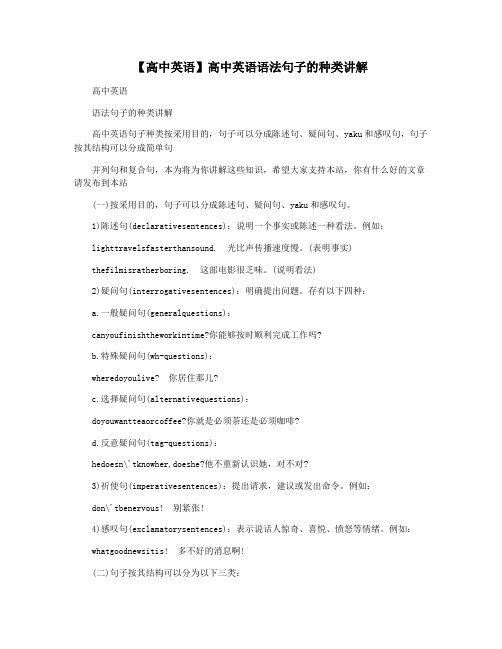
【高中英语】高中英语语法句子的种类讲解高中英语语法句子的种类讲解高中英语句子种类按采用目的,句子可以分成陈述句、疑问句、yaku和感叹句,句子按其结构可以分成简单句并列句和复合句,本为将为你讲解这些知识,希望大家支持本站,你有什么好的文章请发布到本站(一)按采用目的,句子可以分成陈述句、疑问句、yaku和感叹句。
1)陈述句(declarativesentences):说明一个事实或陈述一种看法。
例如:lighttravelsfasterthansound. 光比声传播速度慢。
(表明事实)thefilmisratherboring. 这部电影很乏味。
(说明看法)2)疑问句(interrogativesentences):明确提出问题。
存有以下四种:a.一般疑问句(generalquestions):canyoufinishtheworkintime?你能够按时顺利完成工作吗?b.特殊疑问句(wh-questions):wheredoyoulive? 你居住那儿?c.选择疑问句(alternativequestions):doyouwantteaorcoffee?你就是必须茶还是必须咖啡?d.反意疑问句(tag-questions):hedoesn\'tknowher,doeshe?他不重新认识她,对不对?3)祈使句(imperativesentences):提出请求,建议或发出命令。
例如:don\'tbenervous! 别紧张!4)感叹句(exclamatorysentences):表示说话人惊奇、喜悦、愤怒等情绪。
例如:whatgoodnewsitis! 多不好的消息啊!(二)句子按其结构可以分为以下三类:1)简单句(simplesentences):只涵盖一个主谓结构句子叫做简单句。
比如:sheisfondofcollectingstamps. 她喜欢集邮。
thefoodwasgood,buthehadlittleappetite.食物很精致,但他却没什么胃口。
英语语法∶句子的种类
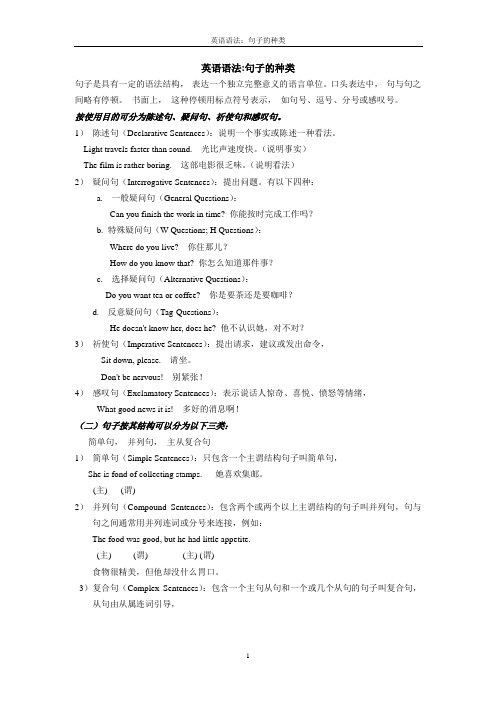
英语语法:句子的种类句子是具有一定的语法结构,表达一个独立完整意义的语言单位。
口头表达中,句与句之间略有停顿。
书面上,这种停顿用标点符号表示,如句号、逗号、分号或感叹号。
按使用目的可分为陈述句、疑问句、祈使句和感叹句。
1)陈述句(Declarative Sentences):说明一个事实或陈述一种看法。
Light travels faster than sound.光比声速度快。
(说明事实)The film is rather boring.这部电影很乏味。
(说明看法)2)疑问句(Interrogative Sentences):提出问题。
有以下四种:a.一般疑问句(General Questions):Can you finish the work in time? 你能按时完成工作吗?b. 特殊疑问句(W Questions; H Questions):Where do you live?你住那儿?How do you know that? 你怎么知道那件事?c.选择疑问句(Alternative Questions):Do you want tea or coffee? 你是要茶还是要咖啡?d.反意疑问句(Tag-Questions):He doesn't know her, does he? 他不认识她,对不对?3)祈使句(Imperative Sentences):提出请求,建议或发出命令,Sit down, please.请坐。
Don't be nervous!别紧张!4)感叹句(Exclamatory Sentences):表示说话人惊奇、喜悦、愤怒等情绪,What good news it is!多好的消息啊!(二)句子按其结构可以分为以下三类:简单句,并列句,主从复合句1)简单句(Simple Sentences):只包含一个主谓结构句子叫简单句,She is fond of collecting stamps.她喜欢集邮。
英语语法中句子的种类
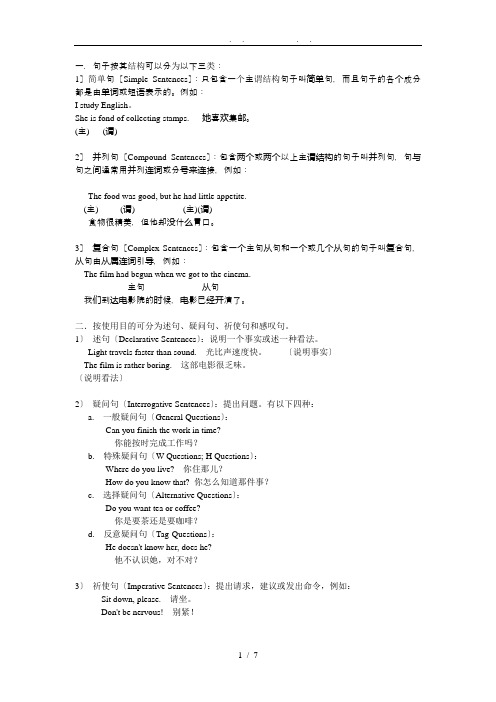
一.句子按其结构可以分为以下三类:1〕简单句〔Simple Sentences〕:只包含一个主谓结构句子叫简单句,而且句子的各个成分都是由单词或短语表示的。
例如:I study English。
She is fond of collecting stamps.她喜欢集邮。
(主)(谓)2〕并列句〔Compound Sentences〕:包含两个或两个以上主谓结构的句子叫并列句,句与句之间通常用并列连词或分号来连接,例如:The food was good, but he had little appetite.(主)(谓)(主)(谓)食物很精美,但他却没什么胃口。
3〕复合句〔Complex Sentences〕:包含一个主句从句和一个或几个从句的句子叫复合句,从句由从属连词引导,例如:The film had begun when we got to the cinema.主句从句我们到达电影院的时候,电影已经开演了。
二.按使用目的可分为述句、疑问句、祈使句和感叹句。
1〕述句〔Declarative Sentences〕:说明一个事实或述一种看法。
Light travels faster than sound.光比声速度快。
〔说明事实〕The film is rather boring.这部电影很乏味。
〔说明看法〕2〕疑问句〔Interrogative Sentences〕:提出问题。
有以下四种:a.一般疑问句〔General Questions〕:Can you finish the work in time?你能按时完成工作吗?b.特殊疑问句〔W Questions; H Questions〕:Where do you live?你住那儿?How do you know that? 你怎么知道那件事?c.选择疑问句〔Alternative Questions〕:Do you want tea or coffee?你是要茶还是要咖啡?d.反意疑问句〔Tag-Questions〕:He doesn't know her, does he?他不认识她,对不对?3〕祈使句〔Imperative Sentences〕:提出请求,建议或发出命令,例如:Sit down, please.请坐。
高三英语语法句子种类与类型(中学课件201911)

1、陈述句 说明一个事实或陈述一个看法,有肯定式和否 定式,语序是主语在前,位于在后。
She arrived early.
I
She cannot have arrived now.
、
注:1)半否定句
句
子
I hardly know anything about it.
种
2)部分否定句与全否定句
类
I don’t like both the films.
类
You need to come, ______ you?
4.He had a big time there, ______ he?
He had a car, ______ he?
We hardly have to get up early, ______ we?
5.He used to live in Leeds, ______ he?
2、疑问句 有一般疑问句、特殊疑问句、选择
疑问句、反义疑问句。
1)一般疑问句 用来询问一件事,答案通常是yes或
I
no,注意语序。
、
Have you anything to say?
句
子
Did someone phone me last night?
种
类
Can’t you understand it?
、
(2)倒装语序
句 子
Whoபைடு நூலகம்are you talking about?
种
类
注:A、简略式
Why not go alone? Why get so angry?
How/What about taking a rest?
初中英语语法大全句子种类

初中英语语法大全句子种类集团标准化工作小组 [Q8QX9QT-X8QQB8Q8-NQ8QJ8-M8QMN]初中英语语法大全-句子的种类按照英语句子的使用目的和用途,句子可分为四类:陈述句(Declarative Sentence)、疑问句(Interrogative Sentence)、祈使句(Imperative Sentence)和感叹句(Exclamatory Sentence)。
陈述句包括肯定陈述句和否定陈述句。
疑问句有一般疑问句、特殊疑问句、选择疑问句和反意疑问句。
图解语法1. 陈述句说明一个事实或陈述一个人的看法,陈述句包括肯定陈述句和否定陈述句特别提示:肯定陈述句改成否定句或一般疑问句时,如句中有already,some,something,somebody等词,须分别改成yet,any,anything,anybody等。
另外,也要注意,too改成either,both改成neither,all改成none 等。
2. 疑问句3. 常用的特殊疑问句4. 特殊的反意疑问句①主句是祈使句时,“will you”意为“请求”,“won’t you”表示提醒对方注意。
例句:Look at the blackboard, will you / won’t youDon’t be late again, will you②感叹句后的反意疑问,用一般现在时态的否定形式例句:What fine weather, isn’t itHow beautifully she sings, doesn’t she③陈述部分是“I am …”时,用“aren’t I”而不用“am not I”例句:I'm working now, aren’t I④陈述部分主语是everything,nothing,anything或something 时,疑问句主语用it例句:Something is wrong with my radio, isn’t itNothing is difficult, is it⑤陈述部分的主语是somebody, nobody, everybody, anybody, no one, none, neither 时,疑问句的主语用they例句:Everyone is here, aren’t theyNo one knows about it, do they⑥陈述部分的主语是:1) this或that时,问句的主语用it2) these或those时,问句主语用they3) there be句时,反意疑问句中用there例句:This is a plane, isn’t itThese are grapes, aren’t theyThere was a hospital here, wasn’t there⑦陈述部分的主语是one时,问句的主语可用one,也可用you (美语用he)例句:One should be ready to help others, shouldn’t one⑧陈述句中有few, seldom, never hardly,not,rarely,no,nobody,too…to等时,疑问句部分用肯定结构;如由前后缀构成否定词,疑问句部分仍用否定结构例句:He is never late for school, is heYou got nothing from him, did youIt is useless, isn’t it⑨陈述部分主语是从句、不定式(短语)、动词-ing形式时,疑问句的主语用it例句:What you need is more important, isn’t it⑩陈述部分由think, believe, suppose, imagine等引导的宾语从句:1) 主语是第一人称时,问句与从句的主谓语一致2) 主语是其他人称,问句与主句的主谓语一致例句:I think he will come, won’t heI don’t think he can pass the exam, can heHe believed you had seen her before, didn’t hehave是实义动词时,疑问句用助动词do,does,did;have 是助动词,则不然例如:They had a meeting just now, didn’t theyShe’s been to many places of interest, hasn’t she陈述部分有have /has /had to 时,疑问句要用助动词的否定形式例句:You have to water the vegetables now, don’t you陈述部分有had better时,疑问句中用hadn’t刘局:We had better go to school at once, hadn’t we陈述部分有must:1) 作“一定;必须”解释时,疑问句用mustn’t或needn’t;2) 表示推测,作“一定是;必定”解释时,疑问句需根据其后的动词原形选用相应的形式;3) 对过去动作推测时,问句的助动词用did或have;4) 对过去的状态推测时,问句的be用was例句:He must work hard at physics, mustn’t heYou must go to Guangzhou, needn’t youYou mustn’t smoke here, must youTom must be at home, isn’t heShe must have finished her work, hasn’t/didn’t sheHe must have been a policeman, wasn’t he陈述部分有ought to,used to,疑问句要用 shouldn’t,usedn’t / didn’t例句:Jill used to be a teacher, usedn’t / didn’t she陈述句部分是复合句时,疑问句的主语和助动词要与主句一致例句:He was reading when the teacher came in, wasn’t he特别提示:反意疑问句是“否定陈述句+肯定问句”时,如回答内容是肯定的,用“Yes+肯定结构”,反之,用“No+否定结构”。
- 1、下载文档前请自行甄别文档内容的完整性,平台不提供额外的编辑、内容补充、找答案等附加服务。
- 2、"仅部分预览"的文档,不可在线预览部分如存在完整性等问题,可反馈申请退款(可完整预览的文档不适用该条件!)。
- 3、如文档侵犯您的权益,请联系客服反馈,我们会尽快为您处理(人工客服工作时间:9:00-18:30)。
Be型 Be+表语(名词或形容词)+其他成分。Be quiet! 安静!
Let型 Let+宾语+动词原形+其他成分。
Let me help you. 让我帮助你。
Do 型: (1) 不及物动词+其他成分。 Come here! 过来! Look! 看! Come in! 进来! (2)及物动词+宾语+其他成分。 Close the door! 关门! Open your books! 翻开课本! Be 型: 系动词+表语+其他成分。 Be quiet, please! 请安静! Be careful! 小心!
(二)祈使句
祈使句表达说话人对对方的劝告、叮嘱、建议、请求或命令 等。主语you通常省略,谓语动词用原形,句末用感叹号或句 号。表达请求或劝告时,祈使句句末或句首可以加上please表 示委婉的语气。
1.肯定祈使句的表现形式:
Do型 动词原形(+宾语)+其他成分。
Please have a seat. 请坐。
Let’s 和 let us 区别: Let’s 包括对方, let us不包括对方。 Let’s go .shall we. 咱么去吧,怎么样? Yes let’s /No let’s not . Let us go, will you? 让我们去吧,行吗?
(三) 感叹句
1.感叹句的概念 感叹句是表示喜怒哀乐等感情的句子,感叹句用感叹号 “!”。
How cold a day (it is)! 多么冷的一天啊!
③How+陈述句 (主语+谓语)!
How I miss you!
我多么想念你啊!
How she loves her daughter!
陈述句变感叹句 一 断 , 二 去, 三 加, 四改变。 一 断, 找到陈述句的主谓,断开句子. 二去, 断开后,如果后部分的中心词是形容词或副词,去掉它们的修饰词. 三加,如果后部分的中心词是名词就加 what, 是形容词或副词就加 How. 四改变, 调整语序,大小写,句末加 ! 陈述句 Tom is very famous. 一断 Tom is / very famous. 二去 Tom is / famous. 三加 Tom is /how famous. 四改变 How famous tom is !
一般疑问句的否定结构的回答:
英语中,一般疑问句的否定结构的回答,是肯定还是否定 取决于答语是肯定还是否定,这点和汉语不同。
Is he not a Frenchman?
他不是法国人吗?
Yes, he is / No, he is not
不 他是 / 是的 他不是
Haven’t you any brothers?
1.一般疑问句 一般疑问句是对一件事情或情况是否真实而提出疑问的句子, 常用yes或no来回答。 —Do you like bananas? ——你喜欢香蕉吗? —Yes, I do. —是的,我喜欢。 (1) Be 动词的一般疑问句 陈述句中有Be动词,直接将Be动词提至主语前。 Is he your friend? Yes ,he is / No , he isn’t
Is there any food to eat ? Yes, there is / No , there isn’t.
进行时和被动语态结含有be 动词所以它们的疑问句和Be动 词的疑问句形式相同。 The baby were crying last night. Were the baby crying last night? Yes they were / No they weren’t English is spoken all over the world. Is English spoken all over the world? Yes it is / No it isn’t
你没有兄弟吗?
Yes , I have / No, I haven’t 不 ,我有 / 是的 我没有。
Don’t you know English? 你不懂英语吗 ? Yes, I do / No, I don’t.
不 部分进行提问的疑问句。 What time do you get up? 你几点起床? 疑问词分为两类: 疑问代词 what who whom (who的宾格) whose (谁的) which (哪个)。 疑问副词 when where why how。
(4) 现在完成时和过去完成时的一般疑问句。 将助动词 have/has /had提至句首。 You have known her since your childhood? Have you known her since your childhood? 你从童年时就认识她吗? Yes I have /No I haven’t He had learned English before he came here? Had he learned English before he came here? 他来这之前就学过英语吗? Yes he had / No he hadn’t.
4.行为动词的否定句
主语+do/does/did + not + 动词原形 They do not live in shanghai. He does not do his home work every day. They did not have the meeting yesterday. She did not pass the English exam yesterday.
(2) 情态动词的一般疑问句。 陈述句中有情态动词,直接将情态动词提至主语前。 You can bring me some bread. Can you bring me some bread? Yes I can / No I can’t I must do it now. Must I do it now? Yes you must / No you need not.
Don’t make such a noise. ②Don’t be late for school! 上学不要迟到!
(2)Let型的否定式有两种: Don’t +let+宾语+动词原形+其他成分 Let+宾语+not+动词原形+ 其他成分 Don’t let him go. /Let him not go. 别让他走。 Let’s/Let us /Let me +not + 动词原形 + 其他成分 Let’s not say anything about it. (3)有些可用no开头,用来表示禁止性的祈使句。 No smoking! 禁止吸烟!
(四)疑问句
用来表示提问的句子叫作疑问句,句末用问号。疑问句包括
一般疑问句、特殊疑问句、选择疑问句和反意疑问句四种。
1 Is she from China ?
一般疑问句
2 When is your birthday?
特殊疑问句
3 Is this a dog or a cat?
选择疑问句
4 You are a student, aren’t you? 反意疑问句
句子的种类
英语的句子按照用途可分为四类:陈述句、疑问句、祈使 句和感叹句。
(一)陈述句
用来陈述一件事实或表达说话者看法的句子叫作陈述句, 句末用句号表示句子的陈述结束。陈述句分为肯定句和否 定句。 I like apples. 我喜欢苹果。 Tom is not good at English. 汤姆英语学得不好。
一般情况下What和 How 可以相互转换:
The boy is clever.
How clever the boy is! 这个孩子是多么聪明! What a clever boy he is ! It is a cold day. How cold a day it is! 多么冷的一天啊! What a cold day it is ! 在口语中 常省略陈述句部分 How cold ! What a cold day !
(3) 实义(行为) 动词的一般疑问句。 陈述句中如只有行为动词,要在句首加助动词 do/ does /did。 He has supper at home every day? Does he have supper at home every day? Yes he does / No he doesn’t He did morning exercise yesterday! Did he do morning exercises yesterday? Yes he did /No he didn’t
What a beautiful city (it is)! 多么美丽的一个城市!
②What+形容词+可数名词复数 (+主语+谓语)!
What clever monkeys! 多么聪明的猴子!
③What+形容词+不可数名词 (+主语+谓语)!
What cold weather it is! 多么寒冷的天气!
2.情态动词的否定句
I can not do it by myself. You must not take the books out. 你一定不能把书拿出去。 3.完成时的否定 I have not finished the job. He has not had his lunch yet. He had not designed any plan by the end of last month.
(2) how引导的感叹句 (中心词是形容词 , 副词或,动词 )
①How + 形容词/副词+ (主语+谓语)!
